Abstract
In this study, the quaternary hybrid of (Zn0.5Co0.5Fe2O4/Mn0.5Ni0.5Fe2O4)@C-MWCNTs with high-performance in low frequency electromagnetic absorption was synthesized via a facile two-step solvothermal synthesis method. The physicochemical properties as well as electromagnetic parameters and microwave absorption performance were characterized by XRD, SEM, TEM, RS, TGA, and VNA, respectively. The results indicate a nuclear-shell morphology of this hybrid for amorphous carbon coated on the surface of Zn0.5Co0.5Fe2O4 and Mn0.5Ni0.5Fe2O4 mixed polycrystalline ferrites. In addition, the MWCNTs synchronously enwind in the nuclear-shell NPs to form a special cross-linking structure. The outstanding low frequency microwave absorption property is attributed to the synergistic effect of dielectric and magnetic loss, better impedance matching condition, and excellent attenuation characteristics of the as-prepared paramagnetic quaternary hybrid. Maximum RL of −35.14 dB at 0.56 GHz with an effective absorption bandwidth in the range of 0.27–1.01 GHz can be obtained with thickness of 5 mm. This hybrid exhibits superior low frequency microwave absorption properties compared with other ferrite-carbon nanocomposites. This investigation provides a new route to prepare suitable candidates for the absorption of electromagnetic waves in a low frequency band on account of its good performance and simple preparation process.
1. Introduction
The rapid development of detection and communication technologies in the military and commercial fields has resulted in more attention being paid to electromagnetic interference (EMI), electromagnetic pollution, and radar stealth. The creation of microwave absorption materials (MAMs) with good performance is an effective approach to address these problems [1,2,3,4]. It is well known that MAMs can attenuate electromagnetic waves by converting electromagnetic energy into heat energy or by dissipating it via all kinds of loss mechanisms. At this stage, MAMs have already been extensively investigated; they include carbon materials [5,6,7], conducting polymers [8,9,10], ceramic materials [11,12,13], magnetic metals and alloys [14,15,16], ferrites [17,18,19], etc. Among these materials, ferrites are widely used as MAMs for their advantages of high Curie temperature, special magnetic property, good chemical and thermo-stability, and low costs [20]. However, pure magnetic ferrites are not sufficient as efficient microwave absorbers due to the unilateral magnetic loss mechanism resulting in a poor impedance matching condition. Generally, the ideal MAMs require strong absorption ability and broad absorbing bandwidth; thus, magnetic ferrites can be modified or composited with other MAMs to optimize their electromagnetic absorption performance. For instance, J. Xiang et al. [21] prepared Ni0.4Co0.2Zn0.4Fe2O4/BaTiO3 fibers via a simple electrospinning and subsequent heat treatment; the maximum reflection loss (RL) value reached −65.6 dB at 15.7 GHz with a broad effective absorption bandwidth below −10 dB of 7.8 GHz for a layer thickness of 5 mm. M.M. Ismail et al. [22] synthesized CoFe2O4/PANI-PTSA composite by sol-gel method; the as-prepared composite presented a wider absorption range and maximum RL was −28.4 dB at 8.1 GHz. Q. Chen et al. [23] fabricated the CIP@SiO2@Mn0.6Zn0.4Fe2O4 composite by using chemical co-precipitation technology; the optimal RL value of the composite with thickness of 2 mm was able to reach up to −44.24 dB at 11.57 GHz as well as bandwidth of RL < −10 dB from 9.04 to 16.16 GHz. S. Acharya et al. [24] prepared a flexible microwave absorber composite by using reduced graphene oxide, strontium ferrite, and poly methyl methacrylate matrix via a simple gel casting technique and in situ polymerization method; more than 99% absorption efficiency was achieved with a suitable combination of dielectric and magnetic coupling in X-band.
In spite of this, present investigations on MAMs are mainly focused in the frequency range of 2–18 GHz. The electromagnetic absorption of these composites is very limited in the low frequency range of 0.1–2 GHz. However, the electromagnetic radiation generated from electronic devices used daily is in a low frequency range, and the detection frequency of many radars e.g. meter-wave radar, phased array radar, spaceborne radar, etc. has been extended to the low frequency region. Hence, this poses a significant challenge in the design of MAMs with outstanding electromagnetic wave absorption capacity in the low frequency band [25,26]. In recent years, L. Zhu et al. [27], K. Zhang et al. [28], and Y. Shao et al. [29] combined Fe3O4 NPs with multi-walled carbon nanotubes (MWCNTs) to enhance the electromagnetic absorption of ferrites for excellent dielectric loss, special one-dimensional nanostructure, low density and resistivity, and good thermal stability of MWCNTs. Moreover, the electromagnetic wave absorption of the composite in a low frequency band can also be heightened with the doping of MWCNTs [30].
Therefore, in the present work, the (Zn0.5Co0.5Fe2O4/Mn0.5Ni0.5Fe2O4)@C-MWCNTs (denoted as (ZCFO/MNFO)@C-MWCNTs henceforth) hybrid was synthesized via a two-step solvothermal method. The phase analysis, micro- and crystal structures, elemental distribution, Raman spectrum, thermogravimetry properties, electromagnetic parameters, and electromagnetic absorption performance of the as-prepared hybrid were characterized by X-Ray diffraction (XRD), scanning electron microscope (SEM), transmission electron microscope (TEM), Raman spectroscopy (RS), thermogravimetric analysis (TGA), and vector network analyzer (VNA) respectively. The intrinsic mechanisms of microwave absorption were also discussed. The results show that the quaternary hybrid can have excellent electromagnetic wave absorbing performance in a low frequency range, and such a hybrid can be used as a promising electromagnetic wave absorber in this band.
2. Experiment
2.1. Materials
Zinc chloride (ZnCl2), cobalt chloride hexahydrate (CoCl2·6H2O), ferric chloride hexahydrate (FeCl3·6H2O), polyethylene glycol-6000, and sodium acetate trihydrate (NaAc) were purchased from Kelong Chemical Reagent Co. Ltd, Chengdu, China. The nickel chloride hexahydrate (NiCl2·6H2O) was purchased from Basf Biotechnology Co. Ltd, Hefei, China. The ethylene glycol and manganese chloride tetrahydrate (MnCl2·4H2O) were purchased from Sinopharm Chemical Reagent Co. Ltd, Shanghai, China. The multi-walled carbon nanotubes were purchased from Xianfeng Nano Technology Co. Ltd, Shuzhou, China.
2.2. Preparation of Zn0.5Co0.5Fe2O4 NPs, Zn0.5Co0.5Fe2O4/Mn0.5Ni0.5Fe2O4 and (Zn0.5Co0.5Fe2O4/Mn0.5Ni0.5Fe2O4)@C-MWCNTs hybrids
The Zn0.5Co0.5Fe2O4 nanoparticles (denoted as ZCFO NPs henceforth) were prepared via the solvothermal synthesis method [31]. In detail, 0.85 g zinc chloride, 1.4875 g cobalt chloride hexahydrate, and 6.75 g ferric chloride hexahydrate were consecutively dissolved in 200 mL ethylene glycol. Then, 18 g sodium acetate trihydrate and 5 g polyethylene glycol-6000 were successively added into the previous solution with ultrasonic dispersion for 30 min. Afterwards, the obtained solution was sealed in a 300 mL Teflon-lined stainless-steel autoclave with temperature of 160 °C maintained for 6 h. ZCFO NPs was separated from the mixed solution with a NbFeB magnet after the reaction, then washed with ethanol for several times to get rid of the residual solution, and dried at 50 °C for 6 h.
The (Zn0.5Co0.5Fe2O4/Mn0.5Ni0.5Fe2O4)@C-MWCNTs hybrid was obtained via the solvothermal method once again, i.e. 1.2375 g manganese chloride tetrahydrate, 1.485 g nickel chloride hexahydrate, and 6.75 g ferric chloride hexahydrate were in order dissolved in 200 mL ethylene glycol. Subsequently, 18 g sodium acetate trihydrate, 5 g polyethylene glycol 6000, and 2.6292 g ZCFO NPs obtained from the previous process and 0.8025 g MWCNTs were added into the above solution with ultrasonic dispersion and persistent stirring for 30 min. Then, the mixed solution was sealed in a Teflon-lined stainless-steel autoclave and the reaction temperature was maintained at 200 °C for 12 h. Finally, the as-prepared product was separated with a magnet and washed with ethanol, after which it was dried at 50 °C for 6 h. MWCNTs content in the as-prepared nanocomposite was ~12 wt%, which was decided as an optimal proportion according to our previous investigations and can be calculated by the mole ratio of reactants [32]. In addition, the preparation of Zn0.5Co0.5Fe2O4/Mn0.5Ni0.5Fe2O4 hybrid (denoted as ZCFO/MNFO henceforth) was done following the same process, without the addition of MWCNTs.
2.3. Characterization
The crystal structures of hybrids were analyzed by an X-ray diffraction system with Cu-Kα radiation of λ = 0.154 nm and scan step of 0.02° (D8-ADVANCE, Bruker Inc., Karlsruhe, German). The superficial micro-morphology of hybrids was characterized by a Scanning Electron Microscope (SEM, SU8100, Hitachi Inc., Tokyo, Japan). The transmission morphology, Selected Area Electron Diffraction (SAED), and elemental distribution were characterized by a Transmission Electron Microscope (TEM, Tecnai G2 F30, FEI Inc., Hillsboro, OR, USA). Raman spectra was measured with a Raman spectroscopy (In Via Reflex) by using a laser wavelength of 532 nm. Data of Thermogravimetric Analysis (TGA) was collected in air at a heating rate of 10 °C/min. The samples used for microwave absorption measurements were prepared by blending the products with paraffin in a mass percentage of 40 wt%; then the prepared samples were pressed into a toroidal shape with Φout = 7.00 mm, Φin = 3.04 mm, and different thicknesses of 2–5 mm. The S-parameters of S11 and S21 can be tested with coaxial transmission and reflection method by using the TD3618C Vector Network Analyzer (VNA, Tianda Co. Ltd, Chengdu, China). Thus, complex permittivity and permeability can be calculated on the basis of Nicolson and Ross’s theory [33].
3. Results and Discussion
The phase composition of the as-prepared hybrids has been confirmed by XRD; the patterns are illustrated in Figure 1. As estimated, the characteristic diffraction peaks of ZCFO at 2θ = 18.29°, 30.08°, 35.44°, 37.06°, 43.06°, 53.45°, 56.97°, 62.59°, 70.95°, and 74.01° are in good agreement with the (111), (220), (311), (222), (400), (422), (511), (440), (620), and (533) planes (JCPDS card no.22-1012). No other impurity peak was observed, confirming the spinel structure of ZCFO ferrite [34]. In addition, the crystal structure of MNFO was found to be quite similar to that of ZCFO; thus, the diffraction peaks of ZCFO/MNFO are almost entirely the same as ZCFO [35]. However, there are two weak impurity peaks at 2θ = 44.51° and 51.85°, assigned to the (111) and (200) planes of less Ni elementary substance (JCPDS card no.04-0850) reduced by ethylene glycol during the secondary hydrothermal reaction. Moreover, it shows that there exists a weak diffraction peak at 2θ = 26.38° corresponding to the (002) plane of MWCNTs (JCPDS card no.41-1487) in the quaternary (ZCFO/MNFO)@C-MWCNTs hybrid, indicating that the MWCNTs is composited well with ferrites. The intensity of this diffraction peak is much weaker than those of ferrites, as the wall thickness of MWCNTs used here is thin enough [36].
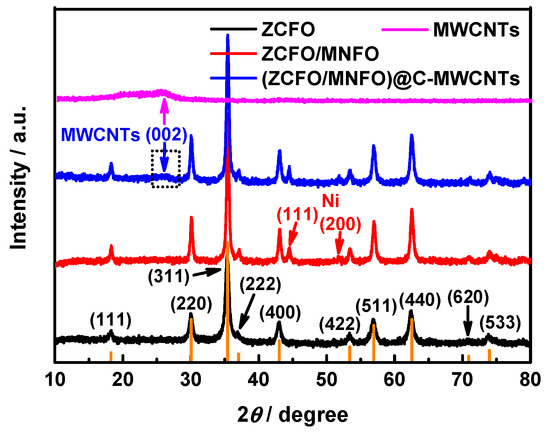
Figure 1.
X-ray diffraction patterns of ZCFO, ZCFO/MNFO, and (ZCFO/MNFO)@C-MWCNTs hybrids.
Figure 2 presents the scanning electron micrograph of the as-prepared hybrids. As shown in Figure 2a, the ZCFO ferrite exhibits ball-like rough NPs, the diameters of which are about ~120 nm. After the second solvothermal reaction, the MNFO ferrite is coated on the surface of ZCFO micro-grains to form the hybrid of ZCFO/MNFO; thus, the particle size of NPs become larger than that of the former. There also exists less-hollow NPs with many micro-grains, as shown in the square area of Figure 2b. Figure 2c shows the distribution of MWCNTs in the quaternary hybrid; it suggests that the MWCNTs are attached to the surface of the NPs and connect the NPs with each other, which is helpful for the conducting loss of micro-current generated from alternating electromagnetic waves. The cleaned quaternary hybrid can be evenly dispersed in the ethanol to form a black suspension liquid, as shown in the left bottom of Figure 2d; however, this hybrid will be drawn aside under the applied magnetic field of a magnet, indicating the macroscopic characteristic of paramagnetism in the (ZCFO/MNFO)@C-MWCNTs hybrid.
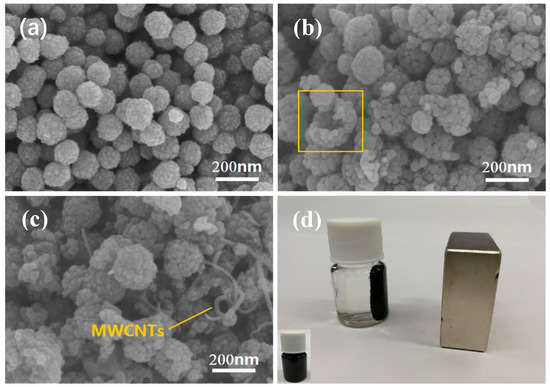
Figure 2.
SEM images of ZCFO (a), ZCFO/MNFO (b), (ZCFO/MNFO)@C-MWCNTs (c), and macro-morphology of the (ZCFO/MNFO)@C-MWCNTs hybrid (d).
Figure 3 shows the transmission electron micrograph of the quaternary hybrid. As shown in Figure 3a, the core of ZCFO/MNFO NPs are formed by many fine micro-grains. Most of the NPs are in the range of 150–230 nm, and some seem to be hollow. Besides, a thin layer of C is coated on the surface of the ZCFO/MNFO NPs and can be clearly seen in Figure 3b; the average thickness of a coated C shell is ~10 nm. The high-resolution transmission electron microscopy image presented in Figure 3c presents clear lattice fringes with spacing of 0.253 nm, accurately displaying the (311) plane of the ZCFO/MNFO core. In addition, the linear distribution of elements on the line displayed in Figure 3a are shown in Figure 3d; it is interesting to note that the Zn, Co, Mn, Ni, Fe, and O elements only exist on the core area of NPs, whose contents are almost close to zero, out of the core area in dashed frames. However, there only exists nonzero content of C element in the shell area, as shown by the arrows, confirming that the shells of NPs are made of carbon, which may be a result of the addition of carbon nanotubes. Moreover, the SAED pattern I of the core area in Figure 3e reveals many diffraction rings corresponding to the (111), (220), (311), (422), (511), and (440) planes of ferrites, further confirming the polycrystalline characteristic of nanoparticles. The SAED pattern II of the shell area displayed in Figure 3f shows the characteristic of an amorphous state in the carbon shell of the NPs. The surface elemental distributions of the (ZCFO/MNFO)@C-MWCNTs hybrid are exhibited in Figure 4; it also indicates that the hybrid consist of Zn, Co, Mn, Ni, Fe, O, and C elements. Except for the C element, the other elements are mainly restricted to the area of ferrite NPs; however, the distribution area of the C element that comes from the MWCNTs is obviously larger than that of the other elements, suggesting a broad distribution of MWCNTs in the hybrid.
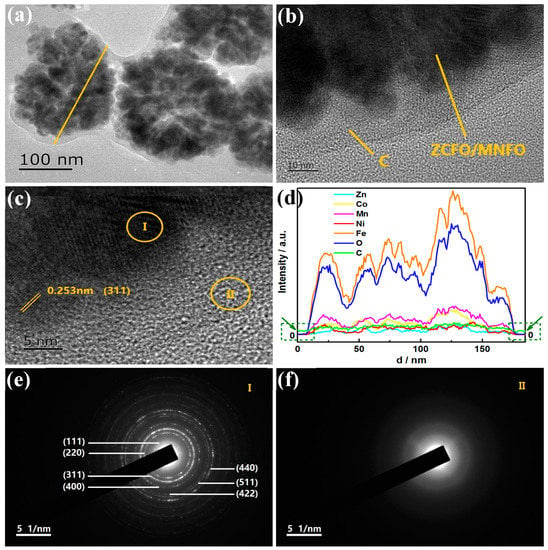
Figure 3.
TEM images with different magnifications (a) and (b), HR-TEM image (c), linear distribution of elements (d) and SAED patterns in different areas (e) and (f) of the (ZCFO/MNFO)@C-MWCNTs hybrid.
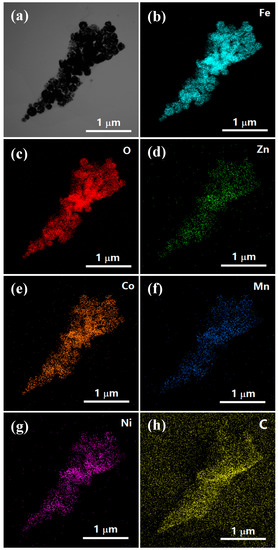
Figure 4.
Surface elemental distribution images of the (ZCFO/MNFO)@C-MWCNTs hybrid (a) TEM image, (b) Fe element, (c) O element, (d) Zn element, (e) Co element, (f) Mn element, (g) Ni element, (h) C element.
Raman spectroscopy is an important technology used to characterize the disorder in sp2 carbon materials. Figure 5 presents the Raman spectrum of MWCNTs and the (ZCFO/MNFO)@C-MWCNTs hybrid. It shows that the Raman spectra of pure MWCNTs exhibits two obvious peaks, marked as D band (~1342 cm−1) and G band (~1577 cm−1), and the intensity ratio of ID/IG is 1.21. In general, the D band corresponds to disordered structures and G band relates to the vibration of sp2-bonded carbon atoms. The intensity of D and G band is weakened after the MWCNTs are composited with ferrites; these two bands are located at ~1340 cm−1 and ~1581 cm−1, respectively. The intensity ratio of ID/IG in the quaternary hybrid is 1.58, which is higher than that of raw MWCNTs, indicating a decrease of in-plane sp2 domains’ size and the increase of unrepaired defects with an enhanced degree of disorder [37]. These defects can be served as polarization centers to initiate dipole polarization and related relaxation, which are advantageous to the enhancement of microwave absorption performance of the as-prepared hybrid [38,39]. Moreover, the peaks of Raman shift at around 472 cm−1, 602 cm−1 and 677 cm−1 correspond to the T2g, A1g and Eg modes of ferrites [36,40]. Usually, the T2g mode represents the characteristic of the octahedral sites, whereas the A1g mode is due to the symmetric stretching of oxygen atoms at the tetrahedral site [41]. Figure 6 displays the TG curves of the ZCFO, ZCFO/MNFO, and (ZCFO/MNFO)@C-MWCNTs hybrids. It can be seen that the weight loss of hybrids during the primary stage is due to the removal of adsorbed water and decomposition of residual organic matter generated from the detergent. The slight weight gain in region II is attributed to the oxidation of ferrites; however, there is a sustained weight loss, as the temperature further increased, which is due to the transformation of ferrites beyond the Curie point and the combustion of MWCNTs. Thus, we can draw a conclusion that the weight percentage of MWCNTs in this quaternary hybrid is ~12 wt%, as expected.
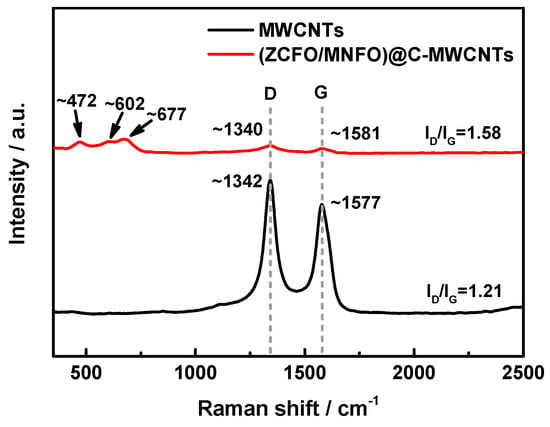
Figure 5.
Raman spectrum of the MWCNTs and (ZCFO/MNFO)@C-MWCNTs hybrid.

Figure 6.
TG curves of ZCFO, ZCFO/MNFO and (ZCFO/MNFO)@C-MWCNTs hybrids.
The complex permittivity (ε = ε′ − jε′′) and permeability (μ = μ′ − jμ′′) of the hybrids are calculated and shown in Figure 7, which are very important in determining the transmission and reflection of electromagnetic waves. As shown in Figure 7a, the real part of permittivity of ZCFO and ZCFO/MNFO are relatively steady; they decrease from 4.88 to 1.82 and 5.75 to 1.83, respectively, when the frequency increased, and the ε′ is enhanced slightly in the whole range to coat MNFO on the surface of the ZCFO micro-grains. However, the ε′ of the quaternary hybrid was observably strengthened in the low frequency domain due to the addition of MWCNTs; it decreases from 35.36 to 1.22 in the range of 0.1~3 GHz owing to the glorious dielectric properties of MWCNTs [42]. The ε′′ of ZCFO increases first and then decreases with the enhancement of frequency in Figure 7b; a peak value of 0.98 at 1.36 GHz can be noted. After cladding, the ε′′ of ZCFO/MNFO is reinforced to 1.40 at 1.22 GHz, whereas, this tendency can be further enhanced by the doping of MWCNTs; the imaginary part of permittivity in the quaternary hybrid achieves 4.89 at 0.23 GHz and be comparatively higher in the measurement range, particularly in the low frequency domain. To the best of our knowledge, the permittivity of hybrid in gigahertz band strongly depends on interfacial polarization and dipole polarization. The formation of a NPs@C core-shell structure due to the addition of MWCNTs and the convolving of MWCNTs among particles will immensely increase multiple interfacial polarization; moreover, the defects in imperfect carbon structure and ferrites, and the oxygen-containing groups on MWCNTs will also enhance dipole polarization of the as-prepared quaternary hybrid. Thus, the ε′ and ε′′ would be enlarged due to the enhancement of dielectric polarization behavior; nevertheless, the generation of displacement current significantly lags behind the build-up potential as the frequency increases, leading to the reduction of both real and imaginary part of permittivity [43,44,45]. Generally speaking, the ε′ of MAMs represents the storage capacity of microwave energy during the transmission process of electromagnetic wave, while the ε′′ shows the microwave energy loss ability [46]; thus, the relatively higher ε′′ in the quaternary hybrid may be helpful for dielectric absorption of the electromagnetic wave. Figure 7c and d show the real and imaginary part of permeability in the as-prepared hybrids. It can be noted that the μ′ of ZCFO and ZCFO/MNFO increase with the enhancement of frequency, and their μ′′ increase first and then decrease. Whereas, there is a surprise phenomenon that both the μ′ and μ′′ would be enhanced to a large extent with the cladding of carbon and doping of MWCNTs; the μ′ increases from 1.86 to 17.6, while the μ′′ decreases from 39.79 to 13.07. This is attributed to that fact that the adhered carbon and MWCNTs can interconnect ferrite NPs in the conductive network, strengthening the coupling effect between different components. As per the theoretical calculation of Kazantseva et al. [47], when the scale of the conductive media is small enough, the effect of conduction currents can be determined by the following dimensionless value:
where, δ is the scale of conductive media, R the radius of ferrite NPs, and Λ can be expressed as:
Here, ω is angular frequency. Hence, the permeability of the hybrid can be varied with different frequencies for the change of R and Λ. This may be the reason why both μ′ and μ′′ increased with the cladding of carbon and doping of MWCNTs [24]. Overall, the complex formation of multi-phases due to the presence of (ZCFO/MNFO)@C encapsulation structure and MWCNTs is responsible for the reinforcement of both complex permeability and permittivity.
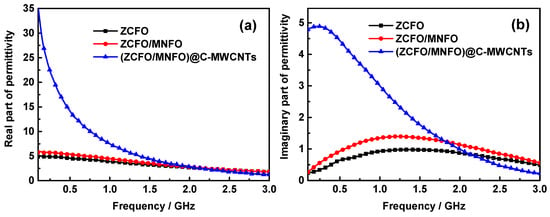

Figure 7.
Frequency dependence of the real part of permittivity (a), imaginary part of permittivity (b), real part of permeability (c), and imaginary part of permittivity (d).
Figure 8 displays the magnetic and dielectric loss tangent of the as-prepared hybrids, as shown in Figure 8a. The dielectric loss of ZCFO, ZCFO/MNFO, and (ZCFO/MNFO)@C-MWCNTs increase first and then decrease with enhancement of frequency; the maximum loss value of ZCFO is 0.33 at 2.23 GHz. However, this peak value is enhanced to 0.41 at 2.22 GHz as MNFO is coated on the surface of ZCFO micro-grains owing to the added interface between different phases, which is beneficial in improving interfacial polarization for microwave absorption [48]. It is interesting to note that this dielectric loss peak shifts to a lower frequency of 1.22GHz with the addition of MWCNTs to enhance ε′′ in a low frequency domain. Moreover, the magnetic loss tangent of (ZCFO/MNFO)@C-MWCNTs in Figure 8b indicates a strong magnetic loss absorption of microwave, particularly in the low frequency domain; this is mainly due to the increased μ′′ of the quaternary hybrid for the reason mentioned above [49].

Figure 8.
Frequency dependence of dielectric loss tangent (a) and magnetic loss tangent (b).
Usually, the electromagnetic absorption of hybrid can be characterized by the parameter of electromagnetic wave reflection loss (RL), which is calculated according to the transmission line theory, as follows [50,51]:
The Zin in Equation (3) is input impedance:
Here, εr is the permittivity, μr the permeability, Z0 the impedance of air, d the thickness of sample, c the velocity of light in vacuum, and f the frequency. Figure 9 is the RL curves of the ZCFO, ZCFO/MNFO, and (ZCFO/MNFO)@C-MWCNTs hybrids at different thickness. As seen in Figure 9a, there is no absorption peak at thickness of 2 mm and maximum RL value is −4.54 dB at 3 GHz; this maximum value is enlarged to −7.11 dB when thickness is 3 mm. Nevertheless, there appears an inconspicuous RL peak of −7.33 dB at 2.84 GHz at 4 mm, and when the thickness is further increased to 5 mm, the maximum peak shift to 2.16 GHz with intensity of −8.29 dB. Figure 9b shows the RL of the ZCFO/MNFO hybrid; it can be noted that the absorption peaks present in the thickness of 3 mm, 4 mm, and 5 mm, and the absorption intensity, are enhanced to −7.79 dB, −9.25 dB, and −9.34 dB, respectively. This is ascribed to the increased interfacial polarization between ZCFO and MNFO. However, this situation will be improved prodigiously as the MWCNTs have been doped in the ferrites to form the quaternary hybrid. It is interesting to note that the maximum RL of 2 mm is −15.95 dB at 2.14 GHz with the −10 dB absorption bandwidth between the frequency range of 1.46–2.88 GHz (1.42 GHz), which is attributed to the preferable synergistic effect of dielectric properties of MWCNTs and magnetic properties of ferrites, as well as the enhanced multi-interface polarization and conduction loss of micro-current in MWCNTs [52].These factors are all conducive to improve the electromagnetic absorption performance of the absorber. The electromagnetic wave absorption properties are further enhanced when the thickness of the quaternary hybrid is further increased to 3 mm, 4 mm and 5 mm; the maximum RL are −19.57 dB at 0.99 GHz (bandwidth below −10 dB is 0.65–1.46 GHz), −23.72 dB at 0.74 GHz (bandwidth below −10 dB is 0.48–1.09 GHz), and −35.14 dB at 0.56 GHz (bandwidth below −10 dB is 0.27–1.01 GHz), respectively. In general, more than 90% electromagnetic wave energy is dissipated during its transmission in hybrid as the RL is below −10 dB, according to the theory of transmission line; here, the maximum absorption peak < −30 dB means that the abrasive electromagnetic wave energy is greater than 99.9% [53]. Moreover, the RL absorption peak moves to the lower frequency region with the addition of thickness in the absorber; this is due to the quarter wavelength resonance effect [54]:
From Equation (5), we can find that the corresponding frequency of the resonance peak will decrease as thickness is increased.
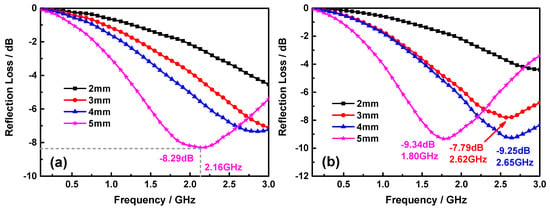
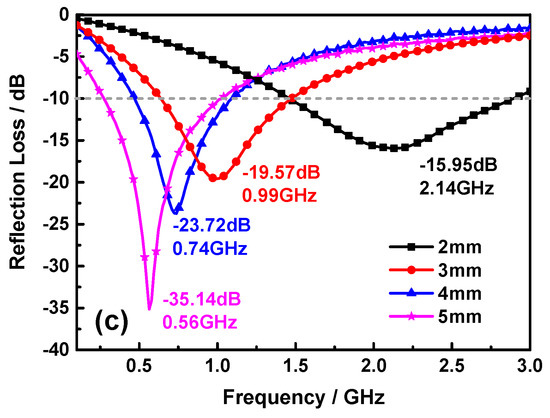
Figure 9.
Frequency-dependent RL curves of ZCFO (a), ZCFO/MNFO (b), and (ZCFO/MNFO)@C-MWCNTs (c) at different thickness.
The impedance matching condition is very important in determining the incidence and reflection of microwave on the surface of the absorber. The more microwaves enter the absorber to be dissipated when the value of |Zin/Z0| is close to one [55]. Figure 10 displays the |Zin/Z0| of the ZCFO, ZCFO/MNFO and (ZCFO/MNFO)@C-MWCNTs hybrids at thickness of 5 mm. It suggests that the optimal impedance matching frequency of these three hybrids are 2.61 GHz, 2.13 GHz, and 0.58 GHz, respectively, which is why the frequency of strong absorption peak in the quaternary hybrid is obviously lower than that of the other two, and more electromagnetic wave is transmitted into the hybrid to be dissipated under suitable matching conditions. In addition, the magnetic loss of the ferrite component is always generated from natural resonance loss, eddy current loss, domain wall resonance loss, and hysteresis loss. However, the domain wall resonance loss generally occurs in MHz range and hysteresis loss is weak in the weak field condition [56]. Thus, the eddy current loss and natural resonance loss are the most probable reasons for the magnetic loss in GHz range; here, the eddy current loss is related to the following formula [57]:
Therefore, the characterization parameter of C0 is calculated as follows [58]:
From Equation (7), we can find that C0 will maintain a constant as the frequency changes, if the magnetic loss originates from the eddy current loss. Figure 11 presents the eddy current loss curves of the as-prepared hybrids. It can be seen that the C0 values are almost constant within the frequency range of 2.0–3.0 GHz for ZCFO and ZCFO/MNFO, indicating that the magnetic loss in this range is mainly due to the eddy current loss, while the natural resonance loss mainly exists in the range of 0.1–2.0 GHz. However, this frequency range of the eddy current loss enlarges to 1.5–3.0 GHz for the (ZCFO/MNFO)@C-MWCNTs quaternary hybrid, and the value of C0 changes dramatically within 0.1–1.5 GHz, manifesting a strong natural resonance loss to enhance the magnetic absorption of the microwave.
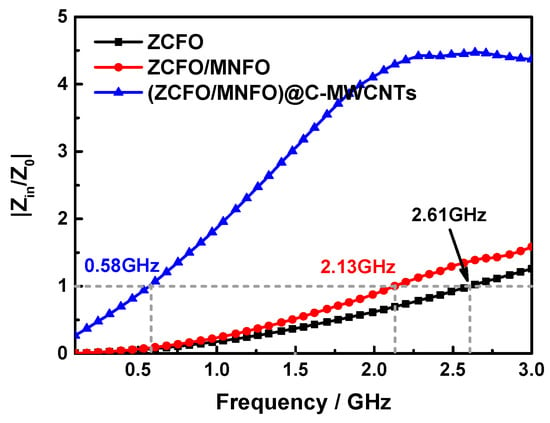
Figure 10.
Frequency dependent |Zin/Z0| values of the ZCFO, ZCFO/MNFO and (ZCFO/MNFO)@C-MWCNTs hybrids at thickness of 5 mm.
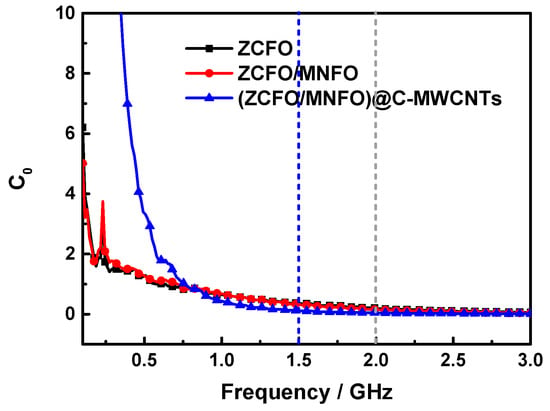
Figure 11.
Eddy current loss curves of the ZCFO, ZCFO/MNFO and (ZCFO/MNFO)@C-MWCNTs hybrids.
The attenuation constant α also gives an important meaning to the electromagnetic absorption ability of hybrids; this attenuation property of the absorber can be deduced as [59,60]:
Figure 12 displays the attenuation constants of the ZCFO, ZCFO/MNFO and (ZCFO/MNFO)@C-MWCNTs hybrids. It shows that the α of a single ZCFO is limited and there is a maximum value of 80.14 at 2.78 GHz. This situation can be improved in the ZCFO/MNFO hybrid—the α increases first and then decreases in the measurement frequency range; the maximum value is enhanced to 90.78 at 2.26 GHz due to the accessorial interface polarization loss between the ZCFO and MNFO ferrites. However, the attenuation constant in the quaternary hybrid is enhanced to a large extent—it also increases initially and decreases afterwards, while the maximum value of α is 235.19 at 1.35 GHz, which is ascribed to the high values of ε′′ and μ′′, indicating the excellent microwave absorption properties of this hybrid. Furthermore, the plots of ε′ and ε′′ in the ZCFO, ZCFO/MNFO and (ZCFO/MNFO)@C-MWCNTs hybrids have been displayed in Figure 13. It can be noted that the ε′-ε″ plots present irregular fluctuation, instead of smooth curves, implying the occurrence of interfacial polarization. For the as-prepared ferrite, NPs are constituted by a great deal of micro-grains, which can provide extensive interfaces. Besides, the core-shell structure of the NPs and the entangled state between the NPs and the MWCNTs bring considerable interfacial polarization [28,61]. Another reason is that defects in the carbon-based quaternary hybrid can produce dipole polarization, which is helpful to further enhance the electromagnetic loss [62]. In addition, according to the free electron theory, electron hopping between divalent and trivalent ions as the electromagnetic field is applied may also be an important factor [63,64]. Thus, the electromagnetic absorption performance of this hybrid containing multiple interface polarization, defect dipole polarization, and electron hopping can be greatly reinforced in the low frequency band.
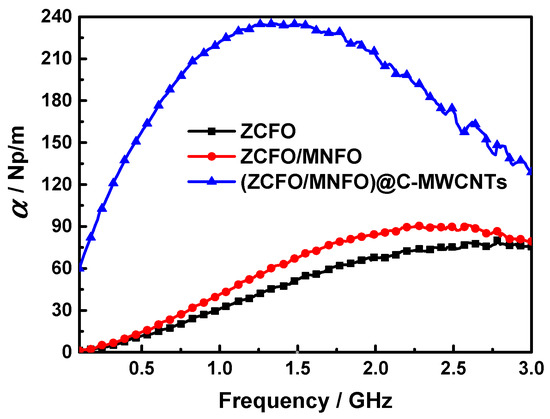
Figure 12.
Attenuation constants of the ZCFO, ZCFO/MNFO, and (ZCFO/MNFO)@C-MWCNTs hybrids.
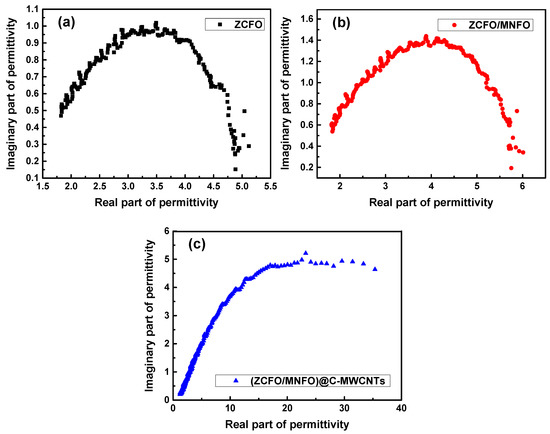
Figure 13.
Plots of ε′−ε′′ for the (a) ZCFO, (b) ZCFO/MNFO, and (c) (ZCFO/MNFO)@C-MWCNTs hybrids.
Table 1 summarizes the electromagnetic wave absorption performances between (ZCFO/MNFO)@C-MWCNTs and related hybrids reported in other literature [65,66,67,68,69,70,71,72,73,74,75]. It is clear that the electromagnetic absorption band of most hybrids are located in the relatively high frequency range. Although the effective absorption bandwidth of the as-synthesized (ZCFO/MNFO)@C-MWCNTs in this work is not wide enough, the hybrid prepared here exhibits superior microwave absorbing performance in low frequency range with an acceptable thickness, which further demonstrates that the (ZCFO/MNFO)@C-MWCNTs is a good candidate for obtaining an enhanced low frequency electromagnetic absorbing property, based on ferrite-carbon nanocomposites.

Table 1.
Comparison of microwave absorption performance between (ZCFO/MNFO)@C-MWCNTs and related hybrids reported in other literature.
4. Conclusions
In summary, the (Zn0.5Co0.5Fe2O4@Mn0.5Ni0.5Fe2O4)@C-MWCNTs hybrid with preeminent electromagnetic wave absorption properties in low frequency band was fabricated via a two-step solvothermal synthesis method. The significant electromagnetic absorption properties of the as-prepared paramagnetic quaternary hybrid are attributed to the synergistic effect of dielectric loss (e.g. multiple interface polarization, defects dipole polarization, electron hopping etc.), magnetic loss (e.g. eddy current loss, nature resonance etc.), preferable impedance matching condition, and outstanding attenuation characteristics. Hence, the maximum RL of −35.14 dB at 0.56 GHz with an effective absorption bandwidth (RL < −10 dB) in the frequency range of 0.27–1.01 GHz (0.74 GHz) can be obtained when the thickness of the absorber is 5 mm. Most important of all, the processing method used here is very simple, and it provides a new route to prepare suitable candidates for the absorption of microwave in low frequency band.
Author Contributions
Writing—original draft preparation, P.Y.; writing—review and editing, L.Z. and H.W.; methodology, X.F. and J.W.; investigation, H.R. and Y.W.; data curation, J.D. and Y.T.
Funding
This research was funded by Cultivation Project of Sichuan Science and Technology Innovation Seedling Program, grant number 2018128; National Natural Science Foundation of China, grant number 51704242; Natural Science Foundation of Shaanxi Province in China, grant number 2018JM5094; and the APC was funded by Cultivation Project of Sichuan Science and Technology Innovation Seedling Program.
Conflicts of Interest
The authors declare no conflict of interest.
References
- Ling, J.; Zhai, W.; Feng, W.; Shen, B.; Zhang, J.; Zheng, W. Facile preparation of lightweight microcellular polyetherimide/graphene composite foams for electromagnetic interference shielding. ACS Appl. Mater. Interfaces 2013, 5, 2677–2684. [Google Scholar] [CrossRef] [PubMed]
- Chen, X.; Meng, F.; Zhou, Z.; Tian, X.; Shan, L.; Zhu, S.; Xu, X.; Jiang, M.; Wang, L.; Hui, D.; et al. One-step synthesis of graphene/polyaniline hybrids by in situ intercalation polymerization and their electromagnetic properties. Nanoscale 2014, 6, 8140–8148. [Google Scholar] [CrossRef] [PubMed]
- Kong, L.; Yin, X.; Yuan, X.; Yuan, Y.; Zhang, Y.; Liu, X.; Cheng, L.; Zhang, L. Electromagnetic wave absorption properties of graphene modified with carbon nanotube/poly (dimethyl siloxane) composites. Carbon 2014, 73, 185–193. [Google Scholar] [CrossRef]
- Lan, D.; Qin, M.; Yang, R.; Chen, S.; Wu, H.; Fan, Y.; Fu, Q.; Zhang, F. Facile synthesis of hierarchical chrysanthemum-like copper cobaltate-copper oxide composites for enhanced microwave absorption performance. J. Colloid Interface Sci. 2019, 533, 481–491. [Google Scholar] [CrossRef] [PubMed]
- Wang, Y.; Wu, X.; Zhang, W.; Huang, S. One-pot synthesis of MnFe2O4 nanoparticles decorated reduced graphene oxide for enhanced microwave absorption properties. Mater. Technol. 2017, 32, 32–37. [Google Scholar] [CrossRef]
- Wu, H.; Qu, S.; Lin, K.; Qing, Y.; Wang, L.; Fan, Y.; Fu, Q.; Zhang, F. Enhanced low-frequency microwave absorbing property of SCFs@TiO2 composite. Powder Technol. 2018, 333, 153–159. [Google Scholar] [CrossRef]
- Luo, H.; Chen, W.; Zhou, W.; Long, L.; Deng, L.; Xiao, P.; Li, Y. Carbon fiber/Si3N4 composites with SiC nanofiber interphase for enhanced microwave absorption properties. Ceram. Int. 2017, 43, 12328–12332. [Google Scholar] [CrossRef]
- Wang, Y.; Wang, W.; Yu, D. Three-phase heterostructures f-NiFe2O4/PANI/PI EMI shielding fabric with high microwave absorption performance. Appl. Surf. Sci. 2017, 425, 518–525. [Google Scholar] [CrossRef]
- Yun, S.; Kirakosyan, A.; Surabhi, S.; Jeong, J.R.; Choi, J. Controlled morphology of MWCNTs driven by polymer-grafted nanoparticles for enhanced microwave absorption. J. Mater. Chem. C 2017, 5, 8436–8443. [Google Scholar] [CrossRef]
- Ali, N.N.; Atassi, Y.; Salloum, A.; Charba, A.; Malki, A.; Jafarian, M. Comparative study of microwave absorption characteristics of (Polyaniline/NiZn ferrite) nanocomposites with different ferrite percentages. Mater. Chem. Phys. 2018, 211, 79–87. [Google Scholar] [CrossRef]
- Liu, Y.; Feng, Y.; Gong, H.; Zhang, Y.; Lin, X.; Xie, B.; Mao, J. Electromagnetic wave absorption properties of nickel-containing polymerderived SiCN ceramics. Ceram. Int. 2018, 44, 10945–10950. [Google Scholar] [CrossRef]
- Reddy, M.P.; Mohamed, A.M.A.; Ramana, M.V.; Zhou, X.B.; Huang, Q. Spark plasma sintering and microwave electromagnetic properties of MnFe2O4 ceramics. J. Magn. Magn. Mater. 2015, 395, 185–189. [Google Scholar] [CrossRef]
- Wei, H.; Yin, X.; Hou, Z.; Jiang, F.; Xu, H.; Li, M.; Zhang, L.; Cheng, L. A novel SiC-based microwave absorption ceramic with Sc2Si2O7 as transparent matrix. J. Eur. Ceram. Soc. 2018, 38, 4189–4197. [Google Scholar] [CrossRef]
- Wei, C.; Shen, X.; Song, F.; Zhu, Y.; Wang, Y. Double-layer microwave absorber based on nanocrystalline Zn0.5Ni0.5Fe2O4/α-Fe microfibers. Mater. Des. 2012, 35, 363–368. [Google Scholar] [CrossRef]
- Xu, Y.; Yuan, L.; Liang, Z.; Wang, X.; Li, X. A wide frequency absorbing material added CIPs using the fuse deposition modeling. J. Alloys Compd. 2017, 704, 593–598. [Google Scholar] [CrossRef]
- Khani, O.; Shoushtari, M.Z.; Ackland, K.; Stamenov, P. The structural, magnetic and microwave properties of spherical and flake shaped carbonyl iron particles as thin multilayer microwave absorbers. J. Magn. Magn. Mater. 2017, 428, 28–35. [Google Scholar] [CrossRef]
- Wu, H.; Wu, G.; Ren, Y.; Yang, L.; Wang, L.; Li, X. Co2+/Co3+ ratio dependence of electromagnetic wave absorption in hierarchical NiCo2O4-CoNiO2 hybrids. J Mater. Chem. C 2015, 3, 7677–7690. [Google Scholar] [CrossRef]
- Wang, Y.; Wu, X.; Zhang, W.; Huang, S. Synthesis and electromagnetic absorption properties of Ag-coated reduced graphene oxide with MnFe2O4 particles. J. Magn. Magn. Mater. 2016, 404, 58–63. [Google Scholar] [CrossRef]
- Wu, H.; Wu, G.; Wang, L. Peculiar porous α-Fe2O3, γ-Fe2O3 and Fe3O4 nanospheres: Facile synthesis and electromagnetic properties. Powder Technol. 2015, 269, 443–451. [Google Scholar] [CrossRef]
- Lan, Y.; Li, X.; Zong, Y.; Li, Z.; Sun, Y.; Tan, G.; Feng, J.; Ren, Z.; Zheng, X. In-situsynthesis of carbon nanotubes decorated by magnetite nanoclusters and their applications as highly efficient and enhanced microwave absorber. Ceram. Int. 2016, 42, 19110–19118. [Google Scholar] [CrossRef]
- Xiang, J.; Hou, Z.; Zhang, X.; Gong, L.; Wu, Z.; Mi, J. Facile synthesis and enhanced microwave absorption properties of multiferroic Ni0.4Co0.2Zn0.4Fe2O4/BaTiO3 composite fibers. J. Alloys Compd. 2018, 737, 412–420. [Google Scholar] [CrossRef]
- Ismail, M.M.; Rafeeq, S.N.; Sulaiman, J.M.A.; Mandal, A. Electromagnetic interference shielding and microwave absorption properties of cobalt ferrite CoFe2O4/polyaniline composite. Appl. Phys. A 2018, 124, 380. [Google Scholar] [CrossRef]
- Chen, Q.; Li, L.; Wang, Z.; Ge, Y.; Zhou, C.; Yi, J. Synthesis and enhanced microwave absorption performance of CIP@SiO2@Mn0.6Zn0.4Fe2O4 ferrite composites. J. Alloys Compd. 2019, 779, 720–727. [Google Scholar] [CrossRef]
- Acharya, S.; Ray, J.; Patro, T.U.; Alegaonkar, P.; Datar, S. Microwave absorption properties of reduced graphene oxide strontium hexaferrite/poly (methyl methacrylate) composites. Nanotechnology 2018, 29, 115605. [Google Scholar] [CrossRef] [PubMed]
- Wang, H.; Dai, Y.; Gong, W.; Geng, D.; Ma, S.; Li, D.; Liu, W.; Zhang, Z. Broadband microwave absorption of CoNi@C nanocapsules enhanced by dual dielectric relaxation and multiple magnetic resonances. Appl. Phys. Lett. 2013, 102, 223113. [Google Scholar] [CrossRef]
- Han, M.; Liang, D.; Deng, L. Fabrication and electromagnetic wave absorption properties of amorphous Fe79Si16B5 microwires. Appl. Phys. Lett. 2011, 99, 082503. [Google Scholar]
- Zhu, L.; Zeng, X.; Chen, M.; Yu, R. Controllable permittivity in 3D Fe3O4/CNTs network for remarkable microwave absorption performances. RSC Adv. 2017, 7, 26801–26808. [Google Scholar] [CrossRef]
- Zhang, K.; Gao, X.; Zhang, Q.; Chen, H.; Chen, X. Fe3O4 nanoparticles decorated MWCNTs@C ferrite nanocomposites and their enhanced microwave absorption properties. J. Magn. Magn. Mater. 2018, 452, 55–63. [Google Scholar] [CrossRef]
- Shao, Y.; Lu, W.; Chen, H.; Xiao, J.Q.; Qiu, Y.; Chou, T.W. Flexible ultra-thin Fe3O4/MnO2 core-shell decorated CNT composite with enhanced electromagnetic wave absorption performance. Compos. Part B Eng. 2018, 144, 111–117. [Google Scholar] [CrossRef]
- Yu, L.; Lan, X.; Wei, C.; Li, X.; Qi, X.; Xu, T.; Li, C.; Li, C.; Wang, Z. MWCNT/NiO-Fe3O4 hybrid nanotubes for efficient electromagnetic wave absorption. J. Alloys Compd. 2018, 748, 111–116. [Google Scholar] [CrossRef]
- Deng, H.; Li, X.L.; Peng, Q.; Wang, X.; Chen, J.P.; Li, Y.D. Monodisperse magnetic single-crystal ferrite microspheres. Angew. Chem. 2005, 117, 2842–2845. [Google Scholar] [CrossRef]
- Yin, P.; Deng, Y.; Zhang, L.; Wu, W.; Wang, J.; Feng, X.; Sun, X.; Li, H.; Tao, Y. One-step hydrothermal synthesis and enhanced microwave absorption properties of Ni0.5Co0.5Fe2O4/graphene composites in low frequency band. Ceram. Int. 2018, 44, 20896–20905. [Google Scholar] [CrossRef]
- Nicolson, A.M.; Ross, G.F. Measurement of the intrinsic properties of materials by time-domain techniques. IEEE Trans. Instrum. Meas. 1970, 19, 377–382. [Google Scholar] [CrossRef]
- Lemdek, E.M.; Benkhouja, K.; Jaafari, K.; Bettach, M.; Tahiri, M.; Masaif, N.; Jennane; Lotfi, E.M. Structural and magnetic properties of nanometric Zn0.5Co0.5Fe2O4 prepared by hydrothermal method. Mol. Cryst. Liq. Cryst. 2016, 627, 125–132. [Google Scholar] [CrossRef]
- Chicinas, I.; Marinca, T.F.; Neamtu, B.V.; Popa, F.; Isnard, O.; Pop, V. Synthesis, structural, and magnetic properties of nanocrystalline/nanosized manganese-nickel ferrite-Mn0.5Ni0.5Fe2O4. IEEE Trans. Magn. 2014, 50, 2800704. [Google Scholar] [CrossRef]
- Tong, X.; Zeng, M.; Xu, H.; Li, J. Synthesis and lithium storage performance of graphene/Co3O4 microrods hybrids. J. Mater. Sci. Mater. Electron. 2016, 27, 7657–7664. [Google Scholar] [CrossRef]
- Shen, Q.; Yang, J.; Chen, K.L.; Wang, H.; Liu, J.B.; Yan, H. Co3O4 nanorods-graphene composites as catalysts for rechargeable zinc-air battery. J. Solid State Electrochem. 2016, 20, 3331–3336. [Google Scholar] [CrossRef]
- Peng, J.; Peng, Z.; Zhu, Z.; Augustine, R.; Mahmoud, M.M.; Tang, H.; Rao, M.; Zhang, Y.; Li, G.; Jiang, T. Achieving ultra-high electromagnetic wave absorption by anchoring Co0.33Ni0.33Mn0.33Fe2O4 nanoparticles on graphene sheets using microwave-assisted polyol method. Ceram. Int. 2018, 44, 21015–21026. [Google Scholar] [CrossRef]
- Shu, R.; Li, W.; Wu, Y.; Zhang, J.; Zhang, G. Nitrogen-doped Co-C/MWCNTs nanocomposites derived from bimetallic metal-organic frameworks for electromagnetic wave absorption in the X-band. Chem. Eng. J. 2019, 362, 513–524. [Google Scholar] [CrossRef]
- Liu, P.; Huang, Y.; Zhang, X. Cubic NiFe2O4 particles on graphene-polyaniline and their enhanced microwave absorption properties. Compos. Sci. Technol. 2015, 107, 54–60. [Google Scholar] [CrossRef]
- Zhang, X.J.; Wang, G.S.; Cao, W.Q.; Wei, Y.Z.; Liang, J.F.; Guo, L.; Cao, M.S. Enhanced microwave absorption property of reduced graphene oxide (RGO)-MnFe2O4 nanocomposites and polyvinylidene fluoride. ACS Appl. Mater. Interfaces 2014, 6, 7471–7478. [Google Scholar] [CrossRef] [PubMed]
- Wu, F.; Xie, A.M.; Sun, M.X.; Wang, Y.; Wang, M.Y. Reduced graphene oxide (RGO) modified sponge-like polypyrrole (PPy) aerogel for excellent electromagnetic absorption. J. Mater. Chem. A 2015, 3, 14358–14369. [Google Scholar] [CrossRef]
- Liu, Y.; Li, Y.N.; Jiang, K.D.; Tong, G.X.; Lv, T.X.; Wu, W.H. Controllable synthesis of elliptical Fe3O4@C and Fe3O4/Fe@C nanorings for plasmon resonance-enhanced microwave absorption. J. Mater. Chem. C 2016, 4, 7316–7323. [Google Scholar] [CrossRef]
- Wu, M.; Yang, E.; Qi, X.; Xie, R.; Bai, Z.; Qin, S.; Zhong, W.; Du, Y. Constructing different categories of heterostructured magnetic nanoparticles@carbon nanotubes-reduced graphene oxide, and their tunable excellent microwave absorption capabilities. J. Alloys Compd. 2019, 785, 1126–1136. [Google Scholar] [CrossRef]
- Song, W.L.; Cao, M.S.; Lu, M.M.; Liu, J.; Yuan, J.; Fan, L.Z. Improved dielectric properties and highly efficient and broadened bandwidth electromagnetic attenuation of thickness-decreased carbon nanosheet/wax composites. J. Mater. Chem. C 2013, 1, 1846–1854. [Google Scholar] [CrossRef]
- Liu, X.F.; Cui, X.R.; Chen, Y.X.; Zhang, X.J.; Yu, R.H.; Wang, G.S.; Ma, H. Modulation of electromagnetic wave absorption by carbon shell thickness in carbon encapsulated magnetite nanospindles-poly (vinylidene fluoride) composites. Carbon 2015, 95, 870–878. [Google Scholar] [CrossRef]
- Bespyatykh, Y.I.; Kazantseva, N.E. Electromagnetic properties of hybrid polymer composites. J. Commun. Technol. Electron. 2008, 53, 143–154. [Google Scholar] [CrossRef]
- Jia, Q.; Wang, W.; Zhao, J.; Xiao, J.; Lu, L.; Fan, H. Synthesis and characterization of TiO2/polyaniline/graphene oxide bouquet-like composites for enhanced microwave absorption performance. J. Alloys Compd. 2017, 710, 717–724. [Google Scholar] [CrossRef]
- Lakshmi, R.V.; Bera, P.; Chakradhar, R.P.S.; Choudhury, B.; Pawar, S.P.; Bose, S.; Nair, R.U.; Barshilia, H.C. Enhanced microwave absorption properties of PMMA modified MnFe2O4-polyaniline nanocomposites. Phys. Chem. Chem. Phys. 2019, 21, 5068–5077. [Google Scholar] [CrossRef] [PubMed]
- Michielssen, E.; Sajer, J.M.; Ranjithan, S.; Mittra, R. Design of lightweight, broadband microwave absorbers using genetic algorithms. IEEE Trans. Microw. Theory Tech. 1993, 41, 1024–1031. [Google Scholar] [CrossRef]
- Shen, G.; Xu, Z.; Li, Y. Absorbing properties and structural design of microwave absorbers based on W-type La-doped ferrite and carbon fiber composites. J. Magn. Magn. Mater. 2006, 301, 325–330. [Google Scholar] [CrossRef]
- Yu, K.; Zeng, M.; Yin, Y.; Zeng, X.; Liu, J.; Li, Y.; Tang, W.; Wang, Y.; An, J.; He, J.; et al. MWCNTs as conductive network for monodispersed Fe3O4 nanoparticles to enhance the wave absorption performances. Adv. Eng. Mater. 2018, 20, 1700543. [Google Scholar] [CrossRef]
- Du, Y.; Liu, W.; Qiang, R.; Wang, Y.; Han, X.; Ma, J.; Xu, P. Shell thickness-dependent microwave absorption of core-shell Fe3O4@C composites. ACS Appl. Mater. Interfaces 2014, 6, 12997–13006. [Google Scholar] [CrossRef] [PubMed]
- Li, R.; Wang, T.; Tan, G.G.; Zuo, W.L.; Wei, J.Q.; Qiao, L.; Li, F.S. Microwave absorption properties of oriented Pr2Fe17N3-δ particles/paraffin composite with planar anisotropy. J. Alloys Compd. 2014, 586, 239–243. [Google Scholar] [CrossRef]
- Zhang, B.; Feng, Y.; Xiong, J.; Yang, Y.; Lu, H. Microwave-absorbing properties of de-aggregated flake-shaped carbonyl-iron particle composites at 2–18 GHz. IEEE Trans. Magn. 2006, 42, 1778–1781. [Google Scholar] [CrossRef]
- Fang, J.; Liu, T.; Chen, Z.; Wang, Y.; Wei, W.; Yue, X.; Jiang, Z. A wormhole-like porous carbon/magnetic particles composite as an efficient broadband electromagnetic wave absorber. Nanoscale 2016, 8, 8899–8909. [Google Scholar] [CrossRef] [PubMed]
- Lei, Y.; Yao, Z.; Lin, H.; Zhou, J.; Haidry, A.A.; Liu, P. The effect of polymerization temperature and reaction time on microwave absorption properties of Co-doped ZnNi ferrite/polyaniline composites. RSC Adv. 2018, 8, 29344–29355. [Google Scholar] [CrossRef]
- Long, Q.; Xu, Z.; Xiao, H.; Xie, K. A facile synthesis of a cobalt nanoparticle-graphene nanocomposite with high-performance and triple-band electromagnetic wave absorption properties. RSC Adv. 2018, 8, 1210–1217. [Google Scholar] [CrossRef]
- Lu, B.; Huang, H.; Dong, X.L.; Zhang, X.F.; Lei, J.P.; Sun, J.P.; Dong, C. Influence of alloy components on electromagnetic characteristics of core/shell-type Fe-Ni nanoparticles. J. Appl. Phys. 2008, 104, 114313. [Google Scholar] [CrossRef]
- Liu, X.G.; Ou, Z.Q.; Geng, D.Y.; Han, Z.; Xie, Z.G.; Zhang, Z.D. Enhanced natural resonance and attenuation properties in superparamagnetic graphite-coated FeNi3 nanocapsules. J. Phys. D 2009, 42, 155004. [Google Scholar] [CrossRef]
- Guan, Z.J.; Jiang, J.T.; Chen, N.; Gong, Y.X.; Zhen, L. Carbon-coated CoFe-CoFe2O4 composite particles with high and dual-band electromagnetic wave absorbing properties. Nanotechnology 2018, 29, 305604. [Google Scholar] [CrossRef] [PubMed]
- Gao, S.; Wang, Q.; Lin, Y.; Yang, H.; Wang, L. Flower-like Bi0.9La0.1FeO3 microspheres modified by reduced graphene oxide as a thin and strong electromagnetic wave absorber. J. Alloys Compd. 2019, 781, 723–733. [Google Scholar] [CrossRef]
- Li, N.; Huang, G.; Xiao, H.; Feng, Q.; Fu, S. Investigations on structure-dependent microwave absorption performance of nano-Fe3O4 coated carbon-based absorbers. Carbon 2019, 144, 216–227. [Google Scholar] [CrossRef]
- Chen, Y.J.; Xiao, G.; Wang, T.S.; Ouyang, Q.Y.; Qi, L.H.; Ma, Y.; Gao, P.; Zhu, C.L.; Cao, M.S.; Jin, H.B. Porous Fe3O4/carbon core/shell nanorods: Synthesis and electromagnetic properties. J. Phys. Chem. C 2011, 115, 13603–13608. [Google Scholar] [CrossRef]
- Moitra, D.; Hazra, S.; Ghosh, B.K.; Jani, R.K.; Patra, M.K.; Vadera, S.R.; Ghosh, N.N. A facile low temperature method for the synthesis of CoFe2O4 nanoparticles possessing excellent microwave absorption properties. RSC Adv. 2015, 5, 51130–51134. [Google Scholar] [CrossRef]
- Wang, Y.; Zhu, H.; Chen, Y.; Wu, X.; Zhang, W.; Luo, C.; Li, J. Design of hollow ZnFe2O4 microspheres@graphene decorated with TiO2 nanosheets as a high-performance low frequency absorber. Mater. Chem. Phys. 2017, 202, 184–189. [Google Scholar] [CrossRef]
- Javid, M.; Zhou, Y.; Zhou, T.; Wang, D.; Zhou, L.; Shah, A.; Duan, Y.; Dong, X.; Zhang, Z. In-situ fabrication of Fe@ZrO2 nanochains for the heat-resistant electromagnetic wave absorber. Mater. Lett. 2019, 242, 199–202. [Google Scholar] [CrossRef]
- Li, G.; Sheng, L.; Yu, L.; An, K.; Ren, W.; Zhao, X. Electromagnetic and microwave absorption properties of single-walled carbon nanotubes and CoFe2O4 nanocomposites. Mater. Sci. Eng. B 2015, 193, 153–159. [Google Scholar] [CrossRef]
- Feng, C.; Liu, X.; Or, S.W.; Ho, S.L. Exchange coupling and microwave absorption in core/shell-structured hard/soft ferrite-based CoFe2O4/NiFe2O4 nanocapsules. AIP Adv. 2017, 7, 056403. [Google Scholar] [CrossRef]
- Cheng, Y.; Tan, M.; Hu, P.; Zhang, X.; Sun, B.; Yan, L.; Zhou, S.; Han, W. Strong and thermostable SiC nanowires/graphene aerogel with enhanced hydrophobicity and electromagnetic wave absorption property. Appl. Surf. Sci. 2018, 448, 138–144. [Google Scholar] [CrossRef]
- Zhu, T.; Chang, S.; Song, Y.F.; Lahoubi, M.; Wang, W. PVP-encapsulated CoFe2O4/rGO composites with controllable electromagnetic wave absorption performance. Chem. Eng. J. 2019, 373, 755–766. [Google Scholar] [CrossRef]
- Genc, F.; Turhan, E.; Kavas, H.; Topal, U.; Baykal, A.; Sozeri, H. Magnetic and microwave absorption properties of NixZn0.9-xMn0.1Fe2O4 prepared by boron addition. J. Supercond. Nov. Magn. 2015, 28, 1047–1050. [Google Scholar] [CrossRef]
- Lu, S.W.; Yuan, C.J.; Jia, C.X.; Ma, K.M.; Wang, X.Q. Preparation and low-frequency microwave-absorbing properties of MWCNTs/Co-Ni/Fe3O4 hybrid material. Funct. Mater. Lett. 2016, 9, 1650035. [Google Scholar] [CrossRef]
- Lv, H.; Yang, Z.; Wang, P.L.; Ji, G.; Song, J.; Zheng, L.; Zeng, H.; Xu, Z.J. A voltage-boosting strategy enabling a low-frequency, flexible electromagnetic wave absorption device. Adv. Mater. 2018, 30, 1706343. [Google Scholar] [CrossRef] [PubMed]
- Sun, J.C.; He, Z.; Dong, W.; Wu, W.; Tong, G. Broadband and strong microwave absorption of Fe/Fe3C/C coreeshell spherical chains enhanced by dual dielectric relaxation and dual magnetic resonances. J. Alloys Compd. 2019, 782, 193–202. [Google Scholar] [CrossRef]
© 2019 by the authors. Licensee MDPI, Basel, Switzerland. This article is an open access article distributed under the terms and conditions of the Creative Commons Attribution (CC BY) license (http://creativecommons.org/licenses/by/4.0/).